Using GIS Techniques to Determine Appropriate Locations for Constructing Concrete Water Canals in the Baranti Plain of Erbil Governorate, Iraq
Abstract
1. Introduction
2. Materials and Methods
2.1. Study Area
2.2. Data Collection
2.2.1. Digital Elevation Model (DEM)
2.2.2. Land Use and Land Cover Classification
2.2.3. Soil Texture
2.2.4. Rainfall
2.2.5. Groundwater-Monitoring Data
2.3. Methodology
2.3.1. Topographical Analyses
2.3.2. Suitable Zone for Channel Stream
2.3.3. Delineation of the Main Channel Stream
2.3.4. Delineation of Sub-Channel Stream

2.3.5. Delineation of the Branch Channel Stream
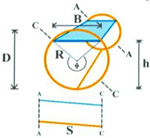
2.3.6. Pumping Station
3. Results
3.1. Result of Land Use and Land Cover Classification
3.2. Topographical Result
3.3. Rainfall
3.4. Soil Texture
3.5. Groundwater-Monitoring-Result Data
3.6. Results of the Open Channel Stream
3.7. Result for Delineation Suitable Zone
3.8. Result of the Main Channel Stream
3.9. Result of the Sub-Main Channel Stream
3.10. Result of the Branch Channel Stream
3.11. Result of the Pumping Station
4. Discussion
5. Conclusions and Recommendations
5.1. Conclusions
5.2. Recommendations
- ➢
- Utilize surface water instead of groundwater.
- ➢
- Constructing concrete channels is the most effective approach. As a result of this discussion, we have made this discovery.
- ➢
- Construct ponds in suitable places to collect rainwater.
- ➢
- Organize awareness courses for farmers to comprehend the risks associated with water scarcity.
- ➢
- Encourage farmers to adopt new irrigation types instead of conventional ones.
- ➢
- Restrict new well drilling.
- ➢
- Government should subsidize crops that do not use extensive water.
Author Contributions
Funding
Data Availability Statement
Acknowledgments
Conflicts of Interest
References
- Downs, P.; Gregory, K. River Channel Management: Towards Sustainable Catchment Hydro Systems; Routledge: Abingdon, UK, 2004. [Google Scholar]
- Prinz, D. Rainwater Harvesting for Domestic Use. Water 1996, 8, 1–10. [Google Scholar]
- Mzirai, O.; Tumbo, S. Macro-catchment rainwater harvesting systems: Challenges and opportunities to access runoff. J. Anim. Plant Sci. 2010, 7, 789–800. [Google Scholar]
- Solomon, B.D. Intergovernmental panel on climate change (IPCC). In Dictionary of Ecological Economics; Edward Elgar Publishing: Cheltenham, UK, 2023; p. 302. [Google Scholar]
- Apaydin, A. Response of groundwater to climate variation: Fluctuations of groundwater level and well yields in the Halacli aquifer (Cankiri, Turkey). Environ. Monit. Assess. 2009, 165, 653–663. [Google Scholar] [CrossRef]
- Bhalage, P.; Jadia, B.; Sangale, S. Case Studies of Innovative Irrigation Management Techniques. Aquat. Procedia 2015, 4, 1197–1202. [Google Scholar] [CrossRef]
- Lehner, B.; Grill, G. Global river hydrography and network routing: Baseline data and new approaches to study the world’s large river systems. Hydrol. Process. 2013, 27, 2171–2186. [Google Scholar] [CrossRef]
- Ferdowsi, A.; Valikhan-Anaraki, M.; Mousavi, S.-F.; Farzin, S.; Mirjalili, S. Developing a model for multi-objective optimization of open channels and labyrinth weirs: Theory and application in Isfahan Irrigation Networks. Flow Meas. Instrum. 2021, 80, 101971. [Google Scholar] [CrossRef]
- Meijer, K.; Boelee, E.; Augustijn, D.; van der Molen, I. Impacts of concrete lining of irrigation canals on availability of water for domestic use in southern Sri Lanka. Agric. Water Manag. 2006, 83, 243–251. [Google Scholar] [CrossRef]
- Martin, C.A.; Gates, T.K. Uncertainty of canal seepage losses estimated using flowing water balance with acoustic Doppler devices. J. Hydrol. 2014, 517, 746–761. [Google Scholar] [CrossRef]
- Jury, W.A.; Vaux, H.J., Jr. The emerging global water crisis: Managing scarcity and conflict between water users. Adv. Agron. 2007, 95, 1–76. [Google Scholar]
- Balaban, A. Sulama Fiebekelerinde Kanal ve Tarla Arkları Sızma Kayıpları Üzerinde Bir Arafltırma; Ankara Üniversitesi, Ziraat Fakültesi Yayınları: Ankara, Turkey, 1970. [Google Scholar]
- Özel, N.; Bozdağ, Ş.; Baba, A. Effect of Irrigation System on Groundwater Resources in Harran Plain (Southeastern Turkey). J. Food Sci. Eng. 2019, 9, 45–51. [Google Scholar] [CrossRef]
- Abdel-Aziz, T.M. Toshka project: Optimizing scarce water resources for irrigated agriculture. In Proceedings of the International Forum on Water-Resources, Technologies and Management in the Arab World including the 2nd Forum on Water Desalination and Purification Technology Outlook for the Arab World & Non-Governmental Organization Forum, Sharjah, United Arab Emirates, 8–10 May 2005. [Google Scholar]
- Berkoff, J. China: The South–North Water Transfer Project—Is It Justified? Water Policy 2003, 5, 1–28. [Google Scholar] [CrossRef]
- Nong, X.; Shao, D.; Zhong, H.; Liang, J. Evaluation of water quality in the South-to-North Water Diversion Project of China using the water quality index (WQI) method. Water Res. 2020, 178, 115781. [Google Scholar] [CrossRef]
- Kattel, G.R.; Shang, W.; Wang, Z.; Langford, J. China’s south-to-north water diversion project empowers sustainable water resources system in the north. Sustainability 2019, 11, 3735. [Google Scholar] [CrossRef]
- Mohammad, M.S.; Elmastas, N.; Abdullah, H. Temporal change of Urban Land Use: The case of Erbil City. Ecol. Environ. Conserv. Pap. 2021, 27, 48–58. [Google Scholar]
- Abdullah, H.; Omar, D.K.; Polat, N.; Bilgili, A.V.; Sharef, S.H. A Comparison between Day and Night Land Surface Temperatures Using Acquired Satellite Thermal Infrared Data in a Winter Wheat Field. Remote Sens. Appl. Soc. Environ. 2020, 19, 100368. [Google Scholar] [CrossRef]
- University of Alaska System. Available online: http://alaska.edu/ (accessed on 27 October 2022).
- Hamad, T.; Çullu, M.A.; Bilgili, A.V.; Akça, E. Temporal and spatial variation of groundwater level in Barnaty plain districts using GIS and RS data-Case Study: In Erbil City, Iraq. Aust. J. Basic Appl. Sci. 2022, 16, 22–34. [Google Scholar]
- Abdullah, A.S.; Esmail, A.O.; Ali, O.O. Mineralogical properties of oak forest soils in Iraqi Kurdistan region. Iraqi J. Agric. Sci. 2019, 50, 1501–1511. [Google Scholar]
- Hamad, T.A.; Hakan, O. Determining thermal comfort zones for outdoor recreation planning: A case study of Erbil–Iraq. Turk. J. For. Sci. 2020, 4, 133–145. [Google Scholar] [CrossRef]
- Nut, N.; Mihara, M.; Jeong, J.; Ngo, B.; Sigua, G.; Prasad, P.V.; Reyes, M.R. Land use and land cover changes and its impact on soil erosion in stung sangkae catchment of cambodia. Sustainability 2021, 13, 9276. [Google Scholar] [CrossRef]
- Al-Ansari, N.; Ali, A.A.; Knutsson, S. Present Conditions and Future Challenges of Water Resources Problems in Iraq. J. Water Resour. Prot. 2014, 6, 1066–1098. [Google Scholar] [CrossRef]
- Ministry of Water Resources of Iraq. Hydrological Yearbook of Iraq; Ministry of Water Resources of Iraq: Baghdad, Iraq, 2022. [Google Scholar]
- Shekha, Y.A. Evaluation of water quality for Greater Zab River by principal component analysis/factor analysis. Iraqi J. Sci. 2016, 15, 2650–2663. [Google Scholar]
- Warner, J. The Toshka mirage in the Egyptian desert–River diversion as political diversion. Environ. Sci. Policy 2013, 30, 102–112. [Google Scholar] [CrossRef]
- Yesilnacar, M.I.; Gulluoglu, M.S. Hydrochemical characteristics and the effects of irrigation on groundwater quality in Harran Plain, GAP Project, Turkey. Environ. Geol. 2008, 54, 183–196. [Google Scholar] [CrossRef]
- Sallam, O.M.; El Shewy, M.A.; Dawoud, M.A. New Reclamation Mega Projects and Increasing the Pressure on Water System in the Nile Valley and Delta in Egypt. In Proceedings of the WSTA 11th Gulf Water Conference, Muscat, Oman, 20–22 October 2014. [Google Scholar]
- Food and Agriculture Organization of the United Nations. Available online: https://www.fao.org/home/en (accessed on 2 February 2008).
- El Quosy, D.E.D. Mega agricultural projects in Egypt. In Conventional Water Resources and Agriculture in Egypt; Springer: Cham, Switzerland, 2019; pp. 593–604. [Google Scholar]
- Smith, J. Irrigation Capacity of the Haran Plain Project. J. Water Manag. 2020, 45, 100–120. [Google Scholar]
- Aly, M.M.; Abd Elhamid, A.M.I.; Abu-Bakr, H.A.-A.; Shalby, A.; Fayad, S.A.K. Integrated Management and Environmental Impact Assessment of Sustainable Groundwater-Dependent Development in Toshka District, Egypt. Water 2023, 15, 2183. [Google Scholar] [CrossRef]
- Yetis, A.D.; Kahraman, N.; Yesilnacar, M.I.; Kara, H. Groundwater quality assessment using GIS based on some pollution indicators over the past 10 years (2005–2015): A case study from semi-arid Harran plain, Turkey. Water Air Soil Pollut. 2021, 232, 11. [Google Scholar] [CrossRef]
- Al-Muqdadi, S.W.; Mohammed, F.O.; Rudy, A.; Naghshineh, A. Dispute over Water Resource Management–Iraq and Turkey. J. Environ. Prot. 2016, 7, 1096–1103. [Google Scholar] [CrossRef]
- Yousuf, M.A.; Rapantova, N.; Younis, J.H. Sustainable Water Management in Iraq (Kurdistan) as a Challenge for Governmental Responsibility. Water 2018, 10, 1651. [Google Scholar] [CrossRef]
- Yadav, M.; Pandey, G.; Kumar, P. Environmental Flow Assessment (EFA) of Tawi River Discharge at the Jammu Location Using the Global Environmental Flow Calculator (GEFC). Nat. Environ. Pollut. Technol. 2023, 22, 1063–1071. [Google Scholar] [CrossRef]
- Depeweg, H.; Urquieta, E.R. GIS Tools and the Design of Irrigation Canals. Irrig. Drain. 2004, 53, 301–314. [Google Scholar] [CrossRef]
- Cherhabil, S.; Debabeche, M. Experimental Study of Sequent Depths Ratio of Hydraulic Jump in Sloped Trapezoidal Channel. In Proceedings of the Hydraulic Structures and Water System Management, Proceedings of the 6th IAHR International Symposium on Hydraulic Structures, Portland, OR, USA, 27–30 June 2016; Crookston, B., Tullis, B., Eds.; pp. 353–358. [Google Scholar] [CrossRef]



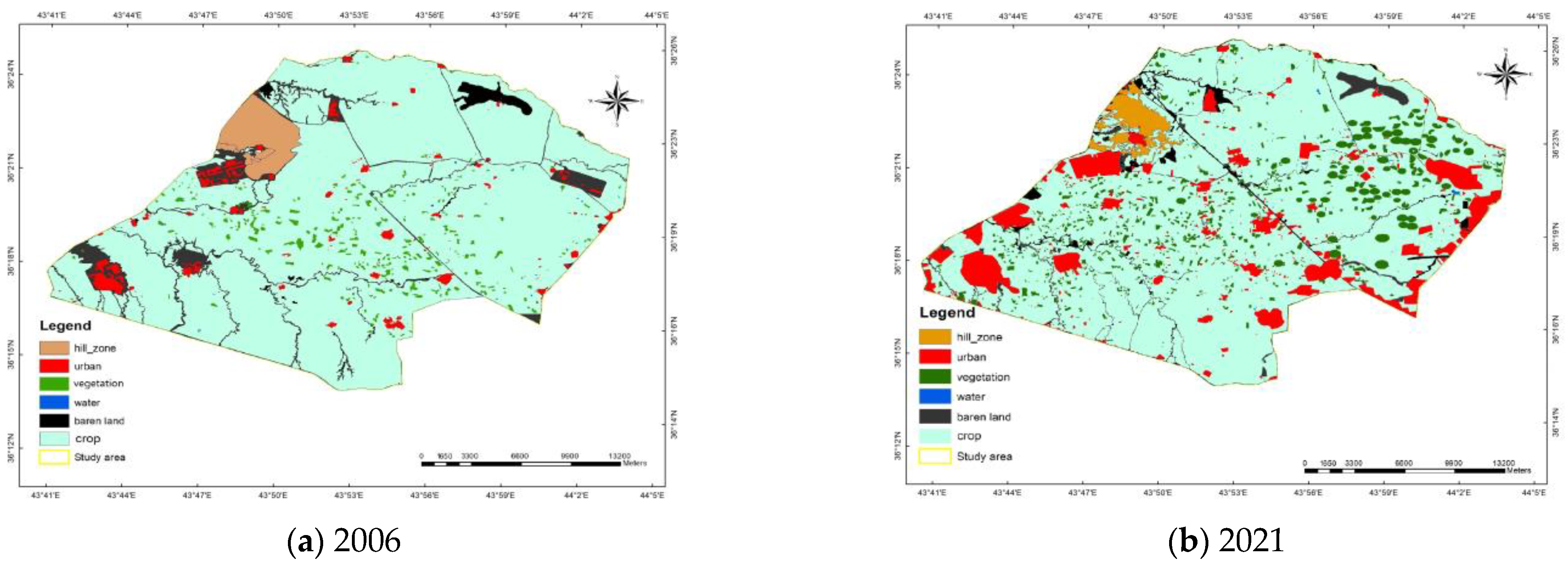
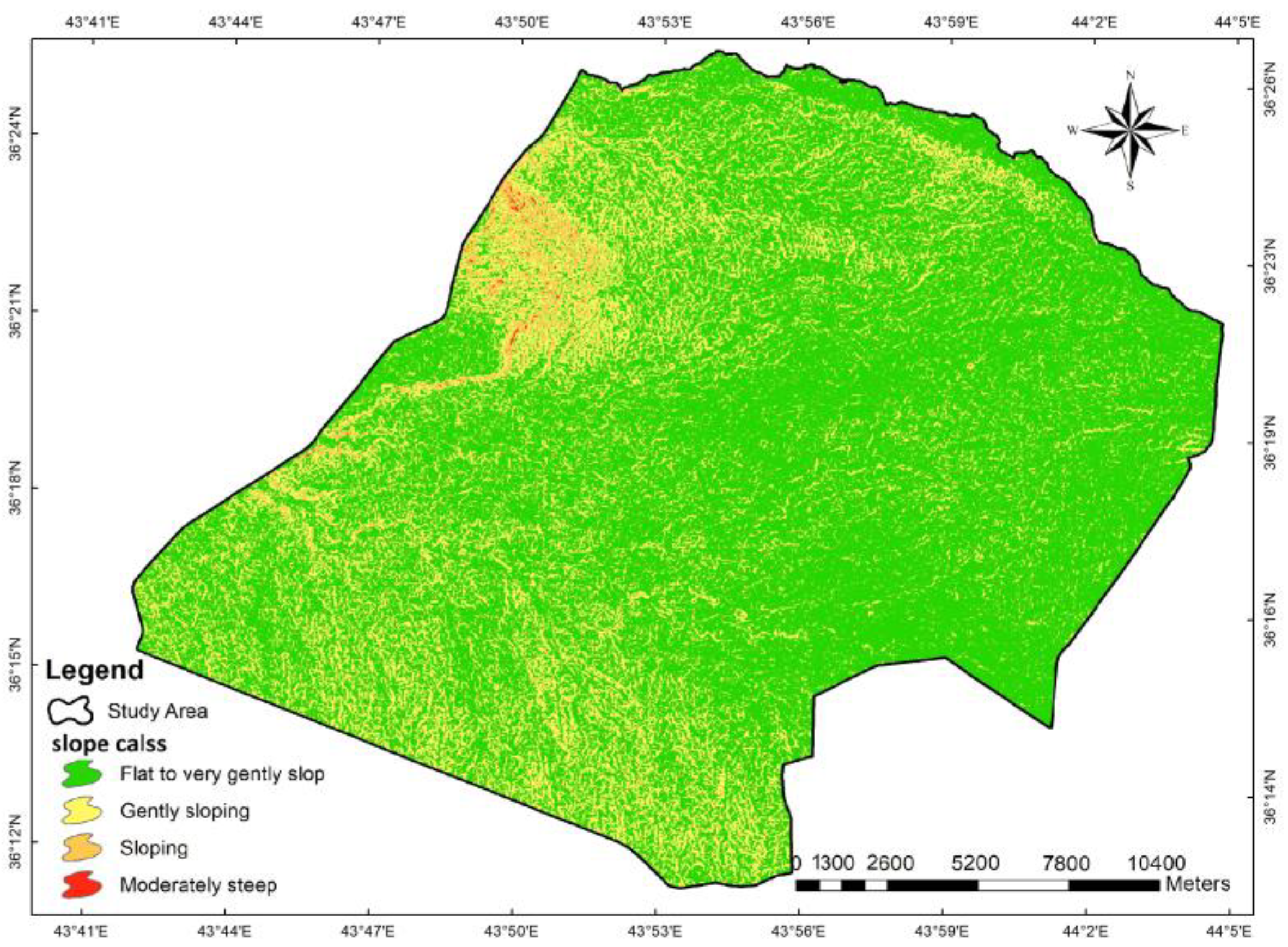

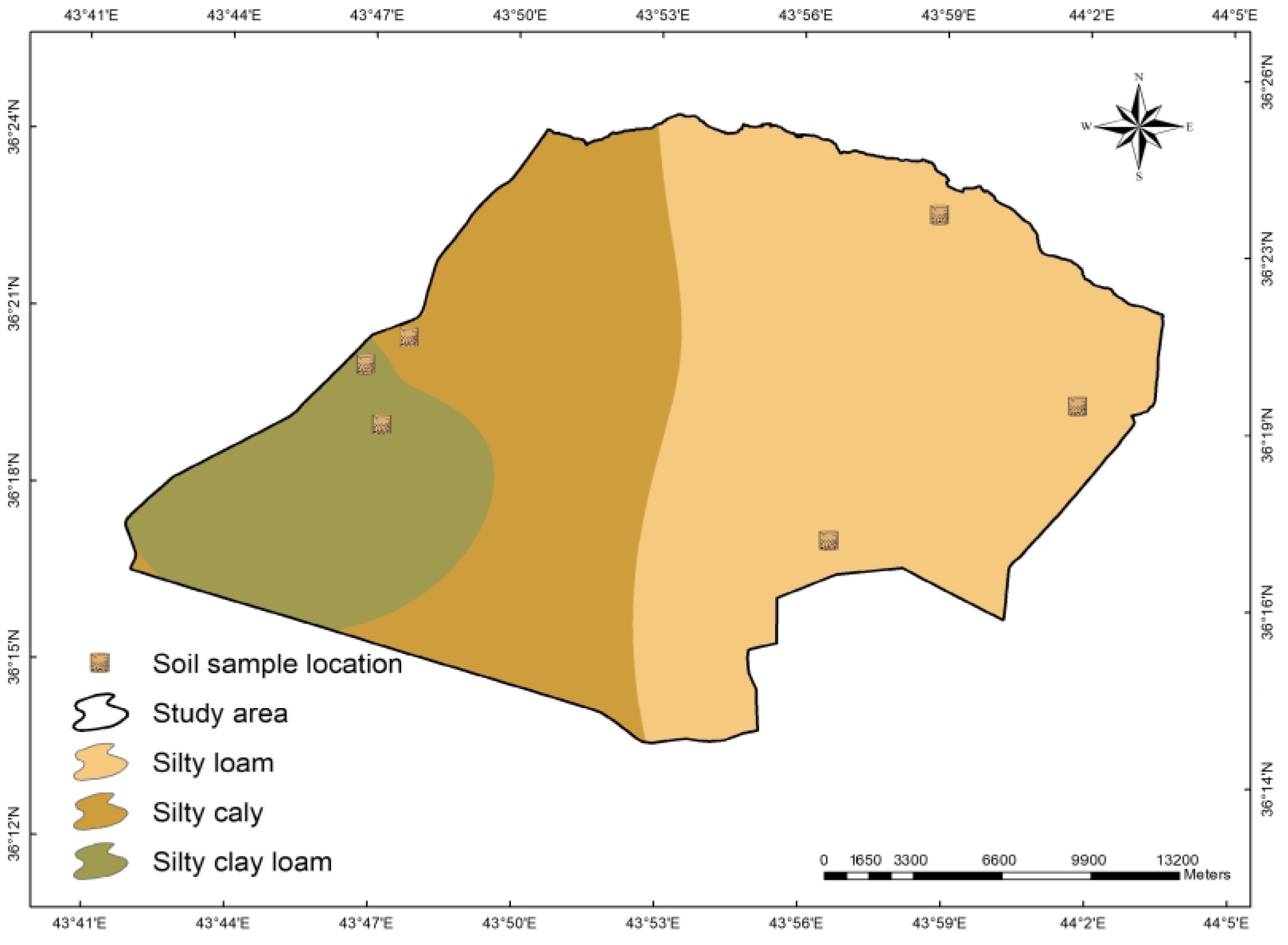

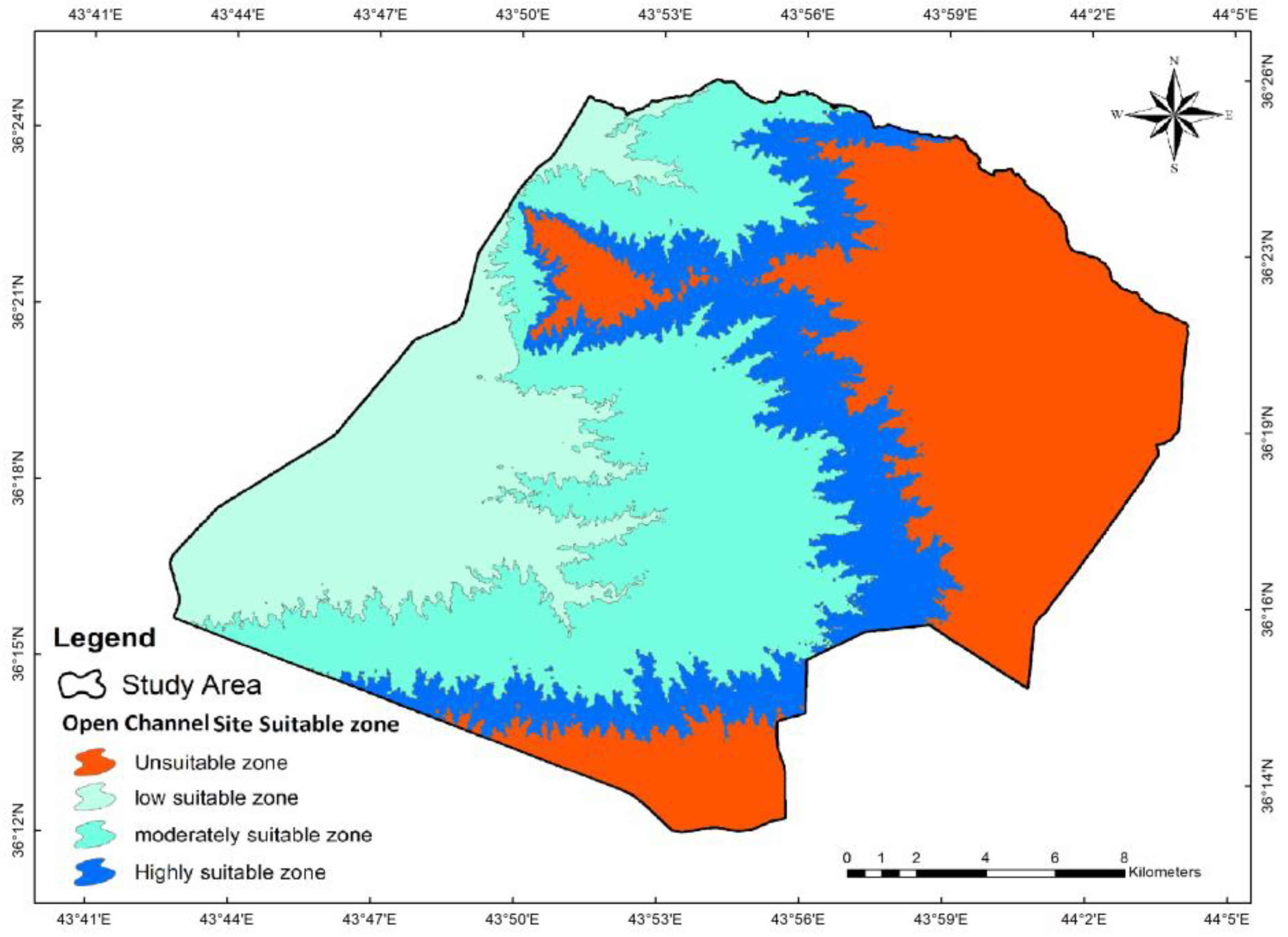
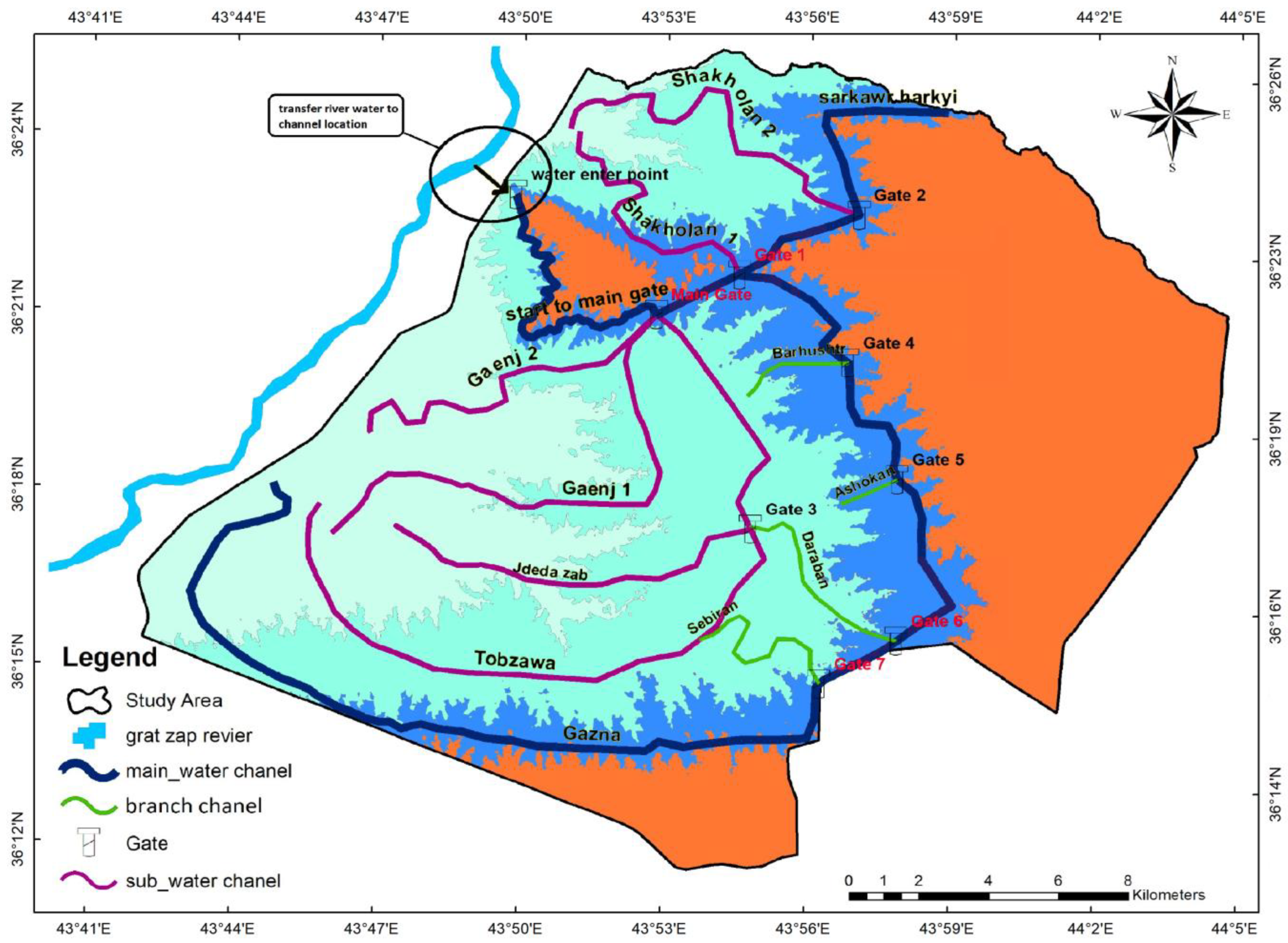

| No. | Name of Village | Latitude | Longitude | Soil Texture |
|---|---|---|---|---|
| 1 | Gazna | 36.278849 | 43.933636 | silty loam |
| 2 | Jazhnikan | 36.393277 | 43.970823 | silty loam |
| 3 | Kawrgosk | 36.350319 | 43.793304 | silty loam |
| 4 | Kawrgosk | 36.340822 | 43.778883 | silty clay loam |
| 5 | Bahrka | 36.325947 | 44.01697 | silty clay |
| 6 | Kawrgosk | 36.319672 | 43.784284 | silty clay loam |
| Class Name | 2006 | 2021 | Change Detection | |||
|---|---|---|---|---|---|---|
| Area (km2) | Area (%) | Area (km2) | Area (%) | Area (%) | ||
| urban | 10.53 | 2.4 | 45.53 | 10.2 | 7.8 | Increase |
| crop | 380 | 85.0 | 342.77 | 76.7 | 8.3 | Decrease |
| vegetation | 8.58 | 1.9 | 29.12 | 6.5 | 4.6 | Increase |
| water | 0.255 | 0.1 | 0.43 | 0.1 | 0.055 | Increase |
| barren land | 32 | 7.2 | 20.94 | 4.7 | 2.5 | Decrease |
| hill zone | 15.69 | 3.5 | 9.22 | 2.1 | 1.4 | Decrease |
| NO. | Slope Classes | Slope % | Area (ha) | Area % |
|---|---|---|---|---|
| 1 | Flat to very gently sloping | <2 | 32,634 | 73.0 |
| 2 | Gently sloping | 2–8 | 11,241 | 25.2 |
| 3 | Sloping | 8–15 | 791 | 1.8 |
| 4 | Moderately steep | 15–30 | 28 | 0.1 |
| 5 | Mountainous | >30 | 0 | 0 |
| No. | Name | Latitude | Longitude | Average Rainfall from 2001 to 2021 (mm) |
|---|---|---|---|---|
| 1 | Bastora | 36.340303 | 44.167739 | 444.1 |
| 2 | Khabat | 36.27865 | 43.69658 | 332.9 |
| 3 | Ankawa | 36.247041 | 43.995148 | 412.9 |
| NO. | Soil Texture | Area (km2) | Area (%) |
|---|---|---|---|
| 1 | silty loam | 241.2 | 54 |
| 2 | silty clay | 132.4 | 29.6 |
| 3 | silty clay loam | 74.4 | 16.6 |
| NO. | Name Village | 2001 | 2021 | Reduction in Groundwater Level by Meter | ||
|---|---|---|---|---|---|---|
| Depth | Date | Depth | Date | |||
| 1 | Gainj gawra | 29.55 | September 2001 | 49.2 | September 2021 | −19.65 |
| 2 | Grda chal | 25 | September 2001 | 35.4 | September 2021 | −10.4 |
| 3 | jadida zab | 39.41 | September 2001 | 74.8 | September 2021 | −35.39 |
| 4 | jazhnikan ababakr | 21.9 | September 2001 | 40.15 | September 2021 | −18.25 |
| 5 | kawer gosk | 31.85 | September 2001 | 85 | September 2021 | −53.15 |
| 6 | qafar | 43.36 | September 2001 | 55.1 | September 2021 | −11.74 |
| 7 | sebirany gawra | 42.13 | September 2001 | 58 | September 2021 | −15.87 |
| Shape Channel | Type of Channel | Type of Slopes | Coefficients (n) | Water Depth (h) m | Bank Slope or Slide Slope (m) | Bottom Width (b) m | Channel Slope m/m | Flow Discharge (Q) m3/s | Flow Velocity (V) m/s | Flow Area (A) m2 | Top Width (B) m | Length of Channel km |
|---|---|---|---|---|---|---|---|---|---|---|---|---|
| Trapezoidal channels | main channel | 100 cm/1 km | 0.02 | 2 | 1 | 2 | 0.001 | 13 | 1.62 | 8 | 6 | 68.2 |
| 50 cm/1 km | 0.02 | 2 | 1 | 2 | 0.0005 | 9 | 1.1 | 8 | 6 | |||
| 25 cm/1 km | 0.02 | 2 | 1 | 2 | 0.00025 | 6.5 | 0.8 | 8 | 6 | |||
| 10 cm/1 km | 0.02 | 2 | 1 | 2 | 0.0001 | 4.1 | 0.5 | 8 | 6 | |||
| sub-channel | 100 cm/1 km | 0.02 | 1 | 1 | 1 | 0.001 | 2 | 1 | 2 | 3 | 86 | |
| 50 cm/1 km | 0.02 | 1 | 1 | 1 | 0.0005 | 1.45 | 0.7 | 2 | 3 | |||
| 25 cm/1 km | 0.02 | 1 | 1 | 1 | 0.00025 | 1 | 0.51 | 2 | 3 | |||
| 10 cm/1 km | 0.02 | 1 | 1 | 1 | 0.0001 | 0.65 | 0.32 | 2 | 3 | |||
| channel angle | channel radius (R) m | |||||||||||
| Circular channels | branch channel | 100 cm/1 km | 0.02 | 0.8 | 277 | 0.5 | 0.001 | 0.48 | 0.7 | 0.67 | 0.8 | 17 |
| 50 cm/1 km | 0.02 | 0.8 | 277 | 0.5 | 0.0005 | 0.34 | 0.5 | 0.67 | 0.8 | |||
| 25 cm/1 km | 0.02 | 0.8 | 277 | 0.5 | 0.00025 | 0.24 | 0.35 | 0.67 | 0.8 | |||
| 10 cm/1 km | 0.02 | 0.8 | 277 | 0.5 | 0.0001 | 0.15 | 0.22 | 0.67 | 0.8 |
| No. | Gate Name | Longitude | Latitude | Elevation (m) | Stream Name | Channel Type | m3/s | Length km |
|---|---|---|---|---|---|---|---|---|
| 1 | Intake Water Gate | 43.8175 | 36.389 | 400 | ifraz | main channel | 9 | 10.5 |
| 2 | Main Gate | 43.8628 | 36.3571 | 395 | tobzawa | sub-channel | 1.45 | 26.7 |
| 3 | Main Gate | 43.8628 | 36.3571 | 395 | Gaenj 1 | sub-channel | 1.45 | 16.3 |
| 4 | Main Gate | 43.8628 | 36.3571 | 395 | Gaenj 2 | sub-channel | 1.45 | 10 |
| 5 | Main Gate | 43.8628 | 36.3571 | 395 | shakholan | main channel | 9 | 2.6 |
| 6 | Gate 1 | 43.8892 | 36.3681 | 393.5 | sarkawr harkyi | main channel | 9 | 10 |
| 7 | Gate 1 | 43.8892 | 36.3681 | 393.5 | Gazna | main channel | 9 | 44 |
| 8 | Gate 1 | 43.8892 | 36.3681 | 393.5 | shakholan 1 | sub-channel | 1.45 | 9.2 |
| 9 | Gate 2 | 43.9272 | 36.3844 | 391.5 | shakholan 2 | sub-channel | 1.45 | 12.4 |
| 10 | Gate 3 | 43.8937 | 36.2994 | 391 | Jdeda zab | sub-channel | 1.45 | 11.3 |
| 11 | Gate 4 | 43.9242 | 36.3446 | 391 | Barhushtr | branch channel | 0.35 | 3.3 |
| 12 | Gate 5 | 43.9403 | 36.3132 | 388.7 | Ashokan | branch channel | 0.35 | 2 |
| 13 | Gate 6 | 43.9405 | 36.2697 | 385.7 | Daraban | branch channel | 0.35 | 6.2 |
| 14 | Gate 7 | 43.9176 | 36.2592 | 384.5 | Sebiran | branch channel | 0.35 | 6.5 |
Disclaimer/Publisher’s Note: The statements, opinions and data contained in all publications are solely those of the individual author(s) and contributor(s) and not of MDPI and/or the editor(s). MDPI and/or the editor(s) disclaim responsibility for any injury to people or property resulting from any ideas, methods, instructions or products referred to in the content. |
© 2024 by the authors. Licensee MDPI, Basel, Switzerland. This article is an open access article distributed under the terms and conditions of the Creative Commons Attribution (CC BY) license (https://creativecommons.org/licenses/by/4.0/).
Share and Cite
Hamad, T.A.; Çullu, M.A.; Bilgili, A.V.; Akça, E.; Ahmed, S.O. Using GIS Techniques to Determine Appropriate Locations for Constructing Concrete Water Canals in the Baranti Plain of Erbil Governorate, Iraq. Water 2024, 16, 448. https://doi.org/10.3390/w16030448
Hamad TA, Çullu MA, Bilgili AV, Akça E, Ahmed SO. Using GIS Techniques to Determine Appropriate Locations for Constructing Concrete Water Canals in the Baranti Plain of Erbil Governorate, Iraq. Water. 2024; 16(3):448. https://doi.org/10.3390/w16030448
Chicago/Turabian StyleHamad, Twana Abdulrahman, Mehmet Ali Çullu, Ali Volkan Bilgili, Erhan Akça, and Soran O. Ahmed. 2024. "Using GIS Techniques to Determine Appropriate Locations for Constructing Concrete Water Canals in the Baranti Plain of Erbil Governorate, Iraq" Water 16, no. 3: 448. https://doi.org/10.3390/w16030448
APA StyleHamad, T. A., Çullu, M. A., Bilgili, A. V., Akça, E., & Ahmed, S. O. (2024). Using GIS Techniques to Determine Appropriate Locations for Constructing Concrete Water Canals in the Baranti Plain of Erbil Governorate, Iraq. Water, 16(3), 448. https://doi.org/10.3390/w16030448







